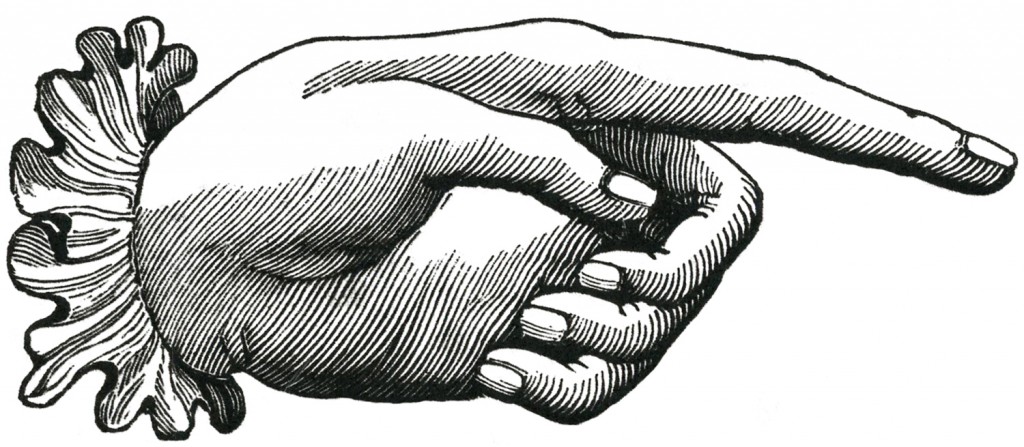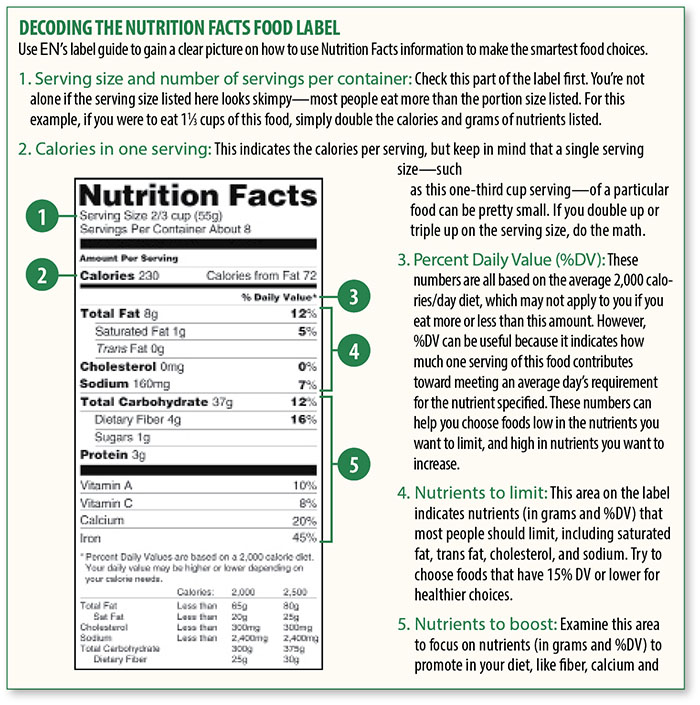41 reading labels on food
How to Read Food Labels | mySugr Reading food labels gives you a better understanding of what's in your food — making it easier to make healthy choices. If you're not paying attention to food labels, you're not getting all the details on your food. Such as the total carbs, sugar, calories, fat, salt, and more. So, how do you read food labels? And what should you be looking for? Reading Food Labels - Food Smart Colorado Daily Value is the amount of a nutrient you should get each day. The % Daily Values tell you what percent of this daily amount is in one serving. 5% Daily Value or less means that a food is a low source of a nutrient. 20% Daily Value or more means that a food is a high source of a nutrient. Limit sodium, sugar, and saturated fat, but get enough ...
Food Labels | CDC If you eat the whole thing, you are eating 8 times the amount of calories, carbs, fat, etc., shown on the label. Total Carbohydrate shows you types of carbs in the food, including sugar and fiber. Choose foods with more fiber, vitamins, and minerals. Choose foods with lower calories, saturated fat, sodium, and added sugars. Avoid trans fat.

Reading labels on food
How to Read Food Labels Without Being Tricked - Healthline Nutrition labels state how many calories and nutrients are in a standard amount of the product — often a suggested single serving. However, these serving sizes are frequently much smaller than what... 10 Tips for Reading Food Labels: What to Look For Serving sizes, calories, total fat, trans fats, sugars, sodium, are all required to be listed on a food label. On the other hand, other aspects such as monounsaturated fat (Vitamin C), polyunsaturated fat (Vitamin A), and insoluble fiber (Vitamin K) no longer need to be provided. The Different Kinds of Fats How To Read Nutrition Labels When reading a nutrition label, the first place you'll want to check out is at the top section. Here is where you'll find important information including: 1. Serving size. Check for how many servings are in the package. This amount is typically provided in units, such as cups or pieces. This is followed by a metric amount, such as the ...
Reading labels on food. Food labels - NHS Some front-of-pack nutrition labels use red, amber and green colour coding. Colour-coded nutritional information tells you at a glance if the food has high, medium or low amounts of fat, saturated fat, sugars and salt: red means high amber means medium green means low In short, the more green on the label, the healthier the choice. Nutrition Facts Labels - How to Read - For Kids - Dr. Smarty Nutrition Facts Labels - How to Read - For Kids - Animation for American Nutrition facts labels explained. Food label reading: Read before you eat - PMC In our study, 57.7% consumers "don't understand" the food labels, whereas 39.7% "partially understand" the food labels information. Nutrition labels typically contain information on calories, serving size, and amounts and/or daily values of several macronutrients, vitamins, and minerals (e.g., fats, carbohydrate, and calcium). Food label reading guide | Nutrition Australia Most food or drink packages have a Nutrition Information Panel (NIP) which tells you the quantity of various nutrients a product contains per serve and per 100g or 100 ml. The NIP will also provide information on the serve size and the number of servings per packet. When reading the NIP: • always read the per 100g column to compare similar ...
Learning To Read Labels :: Diabetes Education Online On a nutrition food label, subtract the fiber from the total carbohydrate amount. When you read food labels, the grams of sugar are already included in the total carbohydrate amount, so you do not need to count this sugar amount separately. The grams of sugar listed include both natural sugars, from fruit or milk, and added sugars. Understanding Food Labels | The Nutrition Source | Harvard T ... Chile implemented the Law of Food Labeling and Advertising in 2016, comprised of mandatory front-of-package (FOP) warning labels, restrictions on child-directed marketing, and the banning of sales in schools of all foods and beverages containing added sugars, sodium, or saturated fats that exceeded set nutrient or calorie thresholds. [1] How to Read a Food Label | Dietitians On Demand Reading a food label can be a skill to develop, The Nutrition Facts food label, first mandated in 1990 and most recently updated in 2016, has evolved to be a wonderful tool to compare food products. However, this tool is only useful if you know how to read and interpret the values that are listed. Reading a food label can be a skill to develop, How to Read a Food Label | Food Allergy Research & Education Starting Jan. 1, 2023, allergen labeling of sesame will be required under the Food Allergy Safety, Treatment, Education and Research (FASTER) Act of 2021. Ingredients and manufacturing processes can change without warning. Make a habit of carefully reading labels to ensure you avoid any potential allergens. "May Contain" Statements
Understanding food labels - Canada.ca Find information on food labels and how to understand them. Learn about nutrition facts tables, serving size, list of ingredients, % daily value and nutrition claims. Food Labeling & Nutrition | FDA Food labeling is required for most prepared foods, such as breads, cereals, canned and frozen foods, snacks, desserts, drinks, etc. Nutrition labeling for raw produce (fruits and vegetables) and... Reading food labels: Tips if you have diabetes - Mayo Clinic Reading food labels can help you make the best choices. Start with the list of ingredients When you're looking at food labels, start with the list of ingredients. Keep an eye out for heart-healthy ingredients, especially those that are less processed, such as whole-wheat flour, soy and oats. Reading Food Labels (for Parents) - Humana - Ohio A food with 5% or less of a nutrient is low in that nutrient. A food with 10%-19% of a nutrient is a good source of that nutrient. A food with 20% or more of a nutrient is high in that nutrient. The information on food labels is based on an average diet of 2,000 calories per day. But the actual number of calories and nutrients that kids need ...
Decoding Labels: So Delicious Coconut Milk - Food Renegade Apr 16, 2015 · If you’re seeing Dr. Pepper ads, it’s likely that you or someone in your household has been searching for soda recipes or reading articles about sodas. I do my best to prevent all food ads from showing up, but some things slip through the cracks because of how they’re categorized. I’ll let my ad manager know about the soda ads, thanks!
How to read food labels - Heart Foundation NZ The star rating is calculated using an algorithm that takes into consideration a number of positive and negative nutrients for a particular food. The positive elements include protein, fibre, fruit, vegetable, nut, seed and legume content. The negative elements include energy, sodium, saturated fat, and sugar.
How to read food labels: MedlinePlus Medical Encyclopedia If a label says that a food has 100 mg of sodium, this means it has about 250 mg of salt. You should eat no more than 2,300 mg of sodium per day. This is the amount of sodium that is in 1 measuring teaspoon of table salt. Ask your health care provider if you should have even less. The % daily value is included on the label as a guide.
How to Read a Food Label - WebMD A 2005 survey by AJ Nielsen & Co. found that half of consumers understood nutrition labels only "in part," although 2 out of 10 said they consistently read them. The secret to reading a food label ...
How to Understand and Use the Nutrition Facts Label | FDA You can use the label to support your personal dietary needs - look for foods that contain more of the nutrients you want to get more of and less of the nutrients you may want to limit. Nutrients...
Understanding Food Nutrition Labels | American Heart Association Learn what to look for on the label. 1 - Start with the serving information at the top. This will tell you the size of a single serving and the total number of servings per container (package). 2 - Next, check total calories per serving and container.
Reading Food Labels | ADA - American Diabetes Association Put food labels to work The Nutrition Facts labels on foods are really the key to making the best choices. We'll cover the basics so that these labels make shopping easier for you. Get started Understanding Carbs You've heard it all. From carb-free to low-carb, to whole and empty carbs, it's hard to know what it all means. Learn more
Food Labels (for Teens) - Nemours KidsHealth A food with 5% or less of a nutrient is low in that nutrient. A food with 10%–19% of a nutrient is a good source of that nutrient. A food with 20% or more of a nutrient is high in that nutrient. The information on food labels is based on an average adult diet of 2,000 calories per day.
A Guide to Reading Food Labels - University of Rochester Feb 27, 2013 · A Guide to Reading Food Labels Reading food labels can help you make wise food choices. Most foods list nutrition information on the package label, called Nutrition Facts. These facts can help you compare foods and choose the healthiest option. Sample Label 1 Serving Size Calories . Limit These . Nutrients . Get Enough of These Nutrients 5 ...
Reading Food Labels - What You Need to Know - Drugs.com Reading labels may also help you to eat less of the nutrients that could cause health problems. Eating too much fat, saturated (SACH-er-ay-ted) fat, trans fat, cholesterol (koh-LES-ter-ol) and sodium may increase your risk for certain health problems. Some of these health problems are heart disease and high blood pressure.

New Food Label Poster - Nutrition Facts Label Poster | Nutrition facts label, Nutrition labels ...
How To Read Food and Beverage Labels | National Institute on Aging There are three types of product dates commonly printed on packaged foods and beverages: "Sell by" tells how long the manufacturer suggests that a store should sell items such as meat, poultry, eggs, or milk products. Make sure you buy by this date. "Use by" tells how long items will be at peak quality.
PDF How to Read the Food Label - Risk Services Look for low- sodium foods with less than 140 mg per serving. Track the total amount you eat. Fiber. Aim for 25 to 38 grams of fiber per day. Sugars: Limit added sugars. Some vitamins and minerals may be listed with DV in one serving. Percent Daily Values (DV) tell you how much you should be eating based on a 2,000 or 2,500 calorie diet.
How to understand food labels | Eat For Health The Nutrition Information Panel on a food label offers the simplest and easiest way to choose foods with less saturated fat, salt (sodium), added sugars and kilojoules, and more fibre. It can also be used to decide how large one serve of a food group choice or discretionary food would be and whether it's worth the kilojoules.
safefood | How to read food labels To make healthier choices, you need to be able to make sense of food labels. Understanding food labels can be tricky. It takes time and practice. Start at home by getting familiar with labels on the foods you eat regularly. Then when you are shopping, compare labels of similar products to find the healthiest option. Here are the things to look ...
How To Read Nutrition Labels When reading a nutrition label, the first place you'll want to check out is at the top section. Here is where you'll find important information including: 1. Serving size. Check for how many servings are in the package. This amount is typically provided in units, such as cups or pieces. This is followed by a metric amount, such as the ...
10 Tips for Reading Food Labels: What to Look For Serving sizes, calories, total fat, trans fats, sugars, sodium, are all required to be listed on a food label. On the other hand, other aspects such as monounsaturated fat (Vitamin C), polyunsaturated fat (Vitamin A), and insoluble fiber (Vitamin K) no longer need to be provided. The Different Kinds of Fats
How to Read Food Labels Without Being Tricked - Healthline Nutrition labels state how many calories and nutrients are in a standard amount of the product — often a suggested single serving. However, these serving sizes are frequently much smaller than what...













Post a Comment for "41 reading labels on food"